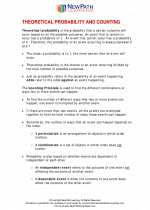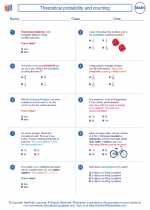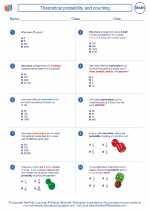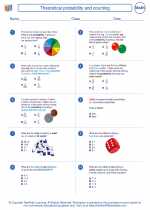Theoretical probability and counting -> triangular prism
Triangular Prism: Definition and Properties
A triangular prism is a three-dimensional shape with two parallel triangular bases and three rectangular faces. The two triangular bases are connected by three rectangular faces that form the sides of the prism.
Key Properties of a Triangular Prism:
- Base: The two parallel bases are triangles with equal sides and angles.
- Faces: A triangular prism has 5 faces - 2 triangular bases and 3 rectangular faces.
- Edges: It has 9 edges, where each edge is shared by one triangular base and one rectangular face.
- Vertices: It has 6 vertices, where three vertices are located on each base.
- Volume: The volume of a triangular prism can be calculated using the formula: V = (1/2) * base area * height, where the base area is the area of the triangle and the height is the perpendicular distance between the two bases.
- Surface Area: The surface area of a triangular prism can be calculated by adding the areas of the two triangular bases and the three rectangular faces.
Example Problem:
Calculate the volume and surface area of a triangular prism with the following dimensions:
Solution:
First, calculate the volume using the formula:
V = (1/2) * base area * height V = (1/2) * (6 cm * 8 cm) * 8 cm V = 24 cm3Next, calculate the surface area by adding the areas of the bases and the rectangular faces:
Surface Area = 2 * (area of the base) + (perimeter of base) * (height of prism) Surface Area = 2 * (1/2 * 6 cm * 8 cm) + (6 cm + 6 cm + 10 cm) * 8 cm Surface Area = 48 cm2 + 176 cm2 Surface Area = 224 cm2Study Guide:
When studying triangular prisms, make sure to understand the relationship between the base, height, and volume. Practice calculating the volume and surface area of different triangular prisms with varying dimensions. Also, familiarize yourself with the properties of a triangular prism, such as the number of faces, edges, and vertices it has.
It's important to be able to visualize and identify triangular prisms in real-world objects, such as buildings, packaging, and geometric structures. Understanding the application of triangular prisms in everyday objects will reinforce your knowledge of their properties and calculations.
Remember to review the formulas for calculating the volume and surface area of a triangular prism, and practice applying them to different examples to strengthen your understanding of this geometric shape.
.◂Math Worksheets and Study Guides Eighth Grade. Theoretical probability and counting

 Worksheet/Answer key
Worksheet/Answer key
 Worksheet/Answer key
Worksheet/Answer key
 Worksheet/Answer key
Worksheet/Answer key
